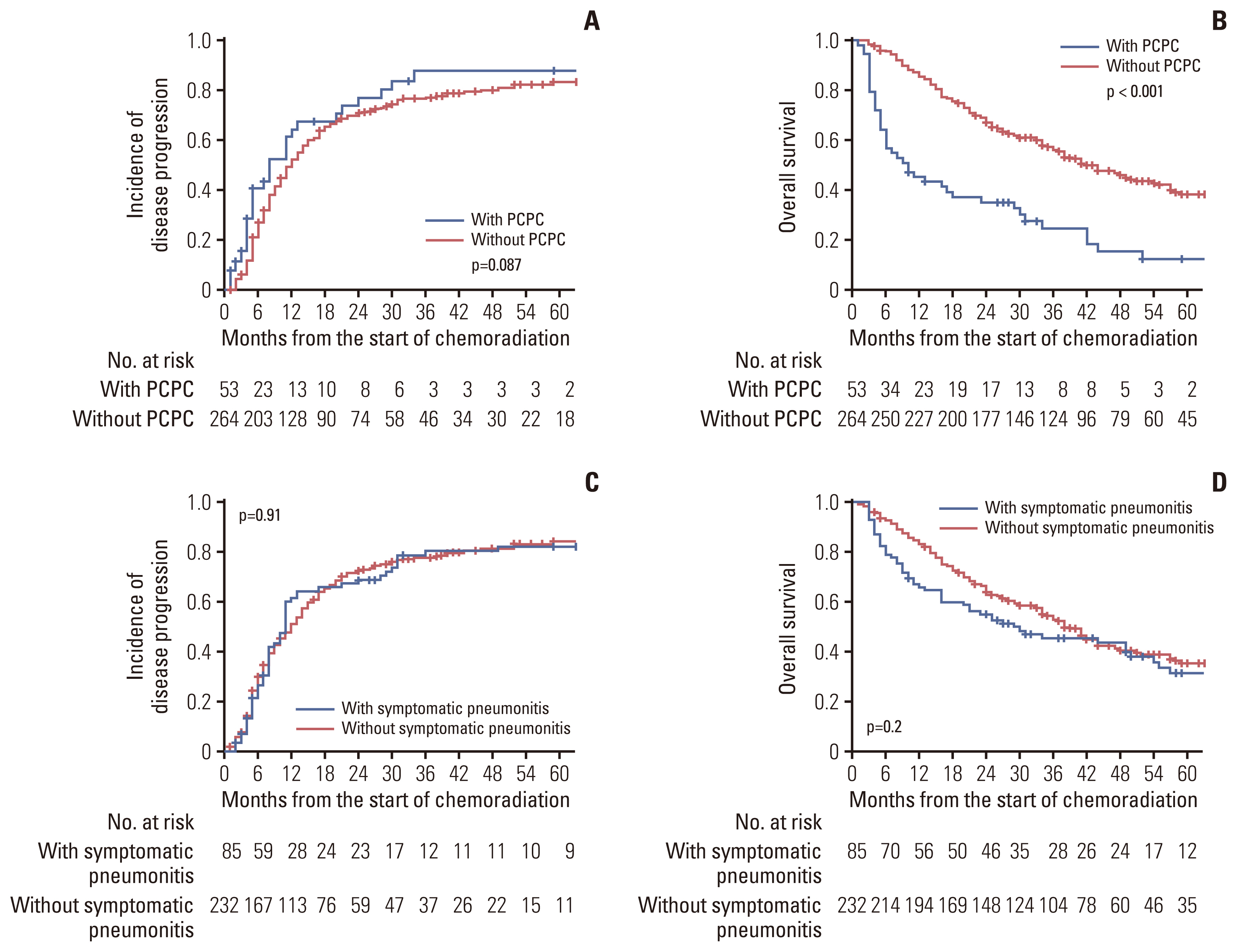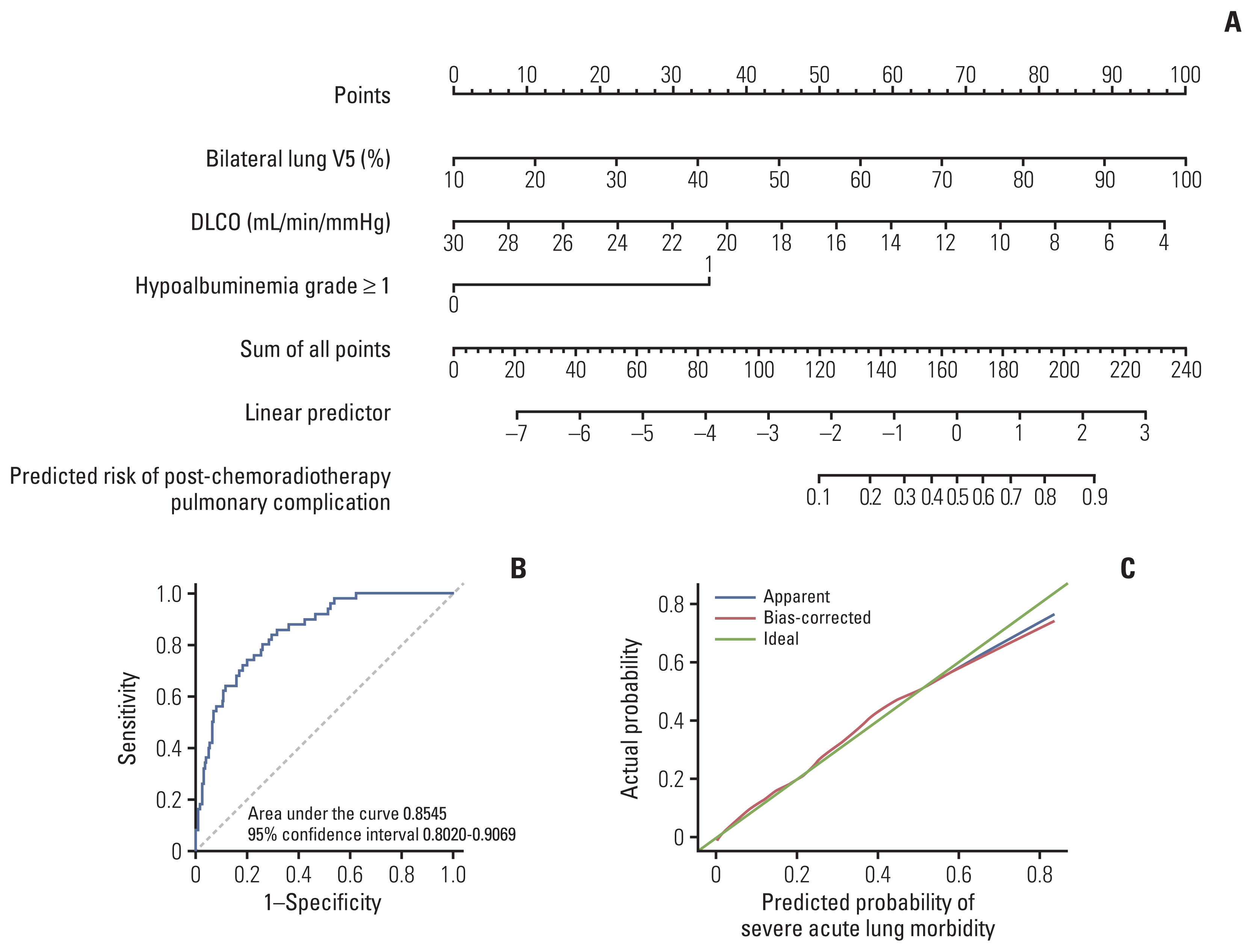Cancer Res Treat.
2023 Jul;55(3):865-874. 10.4143/crt.2022.1538.
Predictors of Post-chemoradiotherapy Pulmonary Complication in Locally Advanced Non–Small Cell Lung Cancer
- Affiliations
-
- 1Department of Radiation Oncology, Seoul National University Hospital, Seoul National University College of Medicine, Seoul, Korea
- 2Department of Radiation Oncology, Seoul National University Bundang Hospital, Seoul National University College of Medicine, Seongnam, Korea
- 3Cancer Research Institute, Seoul National University College of Medicine, Seoul, Korea
- KMID: 2544167
- DOI: http://doi.org/10.4143/crt.2022.1538
Abstract
- Purpose
We investigated the clinical effects and predictive factors of severe post-chemoradiotherapy pulmonary complications (PCPC) in locally advanced non–small cell lung cancer (LA-NSCLC).
Materials and Methods
Medical records of 317 patients who underwent definitive concurrent chemoradiation (CCRT) for LA-NSCLC were reviewed retrospectively. PCPC was defined as an event of admission or emergency department visit for acute or subacute pulmonary inflammatory complications, including pneumonitis and pneumonia, within 6 months after CCRT initiation. Patient characteristics, baseline lung function tests, radiation dosimetric parameters, and laboratory tests were analyzed to investigate their association with PCPC. Prognostic endpoints were disease progression rate (DPR) and overall survival (OS).
Results
PCPC was reported in 53 patients (16.7%). The OS of patients with PCPC was significantly worse (35.0% in 2 years) than that of patients without PCPC (67.0% in 2 years, p < 0.001). However, 2-year DPRs were 77.0% and 70.7% in patients with and without PCPC, respectively, which were not significantly different (p=0.087). In multivariate logistic regression, PCPC was independently associated with grade ≥ 1 hypoalbuminemia during CCRT (odds ratio [OR], 5.670; 95% confidence interval [CI], 2.487 to 13.40; p < 0.001), lower diffusing capacity of carbon monoxide (DLCO) (per mL/min/mmHg; OR, 0.855; 95% CI, 0.743 to 0.974; p=0.022), and higher lung V5 (per 10%; OR, 1.872; 95% CI, 1.336 to 2.699; p < 0.001).
Conclusion
PCPC might be a clinical endpoint to evaluate complications and predict the survival of patients subjected to CCRT for LA-NSCLC. Hypoalbuminaemia, DLCO, and lung V5 might predict PCPC in LA-NSCLC.
Figure
Reference
-
References
1. Sung H, Ferlay J, Siegel RL, Laversanne M, Soerjomataram I, Jemal A, et al. Global cancer statistics 2020: GLOBOCAN estimates of incidence and mortality worldwide for 36 cancers in 185 countries. CA Cancer J Clin. 2021; 71:209–49.
Article2. Morgensztern D, Ng SH, Gao F, Govindan R. Trends in stage distribution for patients with non-small cell lung cancer: a National Cancer Database survey. J Thorac Oncol. 2010; 5:29–33.
Article3. Spigel DR, Faivre-Finn C, Gray JE, Vicente D, Planchard D, Paz-Ares L, et al. Five-year survival outcomes from the PACIFIC trial: durvalumab after chemoradiotherapy in stage III non-small-cell lung cancer. J Clin Oncol. 2022; 40:1301–11.
Article4. Antonia SJ, Villegas A, Daniel D, Vicente D, Murakami S, Hui R, et al. Overall survival with durvalumab after chemoradiotherapy in stage III NSCLC. N Engl J Med. 2018; 379:2342–50.
Article5. Antonia SJ, Villegas A, Daniel D, Vicente D, Murakami S, Hui R, et al. Durvalumab after chemoradiotherapy in stage III non-small-cell lung cancer. N Engl J Med. 2017; 377:1919–29.6. Kuang Y, Pierce CM, Chang HC, Sosinsky AZ, Deitz AC, Keller SM, et al. Chemoradiation-induced pneumonitis in patients with unresectable stage III non-small cell lung cancer: a systematic literature review and meta-analysis. Lung Cancer. 2022; 174:174–85.
Article7. Luna JM, Chao HH, Diffenderfer ES, Valdes G, Chinniah C, Ma G, et al. Predicting radiation pneumonitis in locally advanced stage II–III non-small cell lung cancer using machine learning. Radiother Oncol. 2019; 133:106–12.
Article8. Pallis AG, Agelaki S, Kakolyris S, Kotsakis A, Kalykaki A, Vardakis N, et al. Chemotherapy-induced neutropenia as a prognostic factor in patients with advanced non-small cell lung cancer treated with front-line docetaxel-gemcitabine chemotherapy. Lung Cancer. 2008; 62:356–63.
Article9. Akinosoglou KS, Karkoulias K, Marangos M. Infectious complications in patients with lung cancer. Eur Rev Med Pharmacol Sci. 2013; 17:8–18.10. Benjamini Y, Hochberg Y. Controlling the false discovery rate: a practical and powerful approach to multiple testing. J R Stat Soc Series B Methodol. 1995; 57:289–300.
Article11. Warner A, Dahele M, Hu B, Palma DA, Senan S, Oberije C, et al. Factors associated with early mortality in patients treated with concurrent chemoradiation therapy for locally advanced non-small cell lung cancer. Int J Radiat Oncol Biol Phys. 2016; 94:612–20.12. Tucker SL, Liu A, Gomez D, Tang LL, Allen P, Yang J, et al. Impact of heart and lung dose on early survival in patients with non-small cell lung cancer treated with chemoradiation. Radiother Oncol. 2016; 119:495–500.
Article13. Kim S, McClave SA, Martindale RG, Miller KR, Hurt RT. Hypoalbuminemia and clinical outcomes: what is the mechanism behind the relationship? Am Surg. 2017; 83:1220–7.
Article14. Lai CC, You JF, Yeh CY, Chen JS, Tang R, Wang JY, et al. Low preoperative serum albumin in colon cancer: a risk factor for poor outcome. Int J Colorectal Dis. 2011; 26:473–81.
Article15. Greenblatt DY, Kelly KJ, Rajamanickam V, Wan Y, Hanson T, Rettammel R, et al. Preoperative factors predict perioperative morbidity and mortality after pancreaticoduodenectomy. Ann Surg Oncol. 2011; 18:2126–35.
Article16. Li P, Li J, Lai Y, Wang Y, Wang X, Su J, et al. Perioperative changes of serum albumin are a predictor of postoperative pulmonary complications in lung cancer patients: a retrospective cohort study. J Thorac Dis. 2018; 10:5755–63.17. Morse RT, Ganju RG, Gan GN, Cao Y, Neupane P, Kakarala K, et al. Sarcopenia and treatment toxicity in older adults undergoing chemoradiation for head and neck cancer: identifying factors to predict frailty. Cancers (Basel). 2022; 14:2094.
Article18. Satomi-Tsushita N, Honma Y, Nagashima K, Ito Y, Hirano H, Shoji H, et al. Risk factors of severe benign cicatricial stricture after definitive chemoradiation for localized T3 esophageal carcinoma. Anticancer Res. 2020; 40:1071–7.
Article19. Kang BH, Li X, Son J, Song C, Kang HC, Kim HJ, et al. Prediction and clinical impact of delayed lymphopenia after chemoradiotherapy in locally advanced non-small cell lung cancer. Front Oncol. 2022; 12:891221.
Article20. Gioulbasanis I, Pallis A, Vlachostergios PJ, Xyrafas A, Giannousi Z, Perdikouri IE, et al. The Glasgow Prognostic Score (GPS) predicts toxicity and efficacy in platinum-based treated patients with metastatic lung cancer. Lung Cancer. 2012; 77:383–8.
Article21. Shaverdian N, Veruttipong D, Wang J, Schaue D, Kupelian P, Lee P. Pretreatment immune parameters predict for overall survival and toxicity in early-stage non-small-cell lung cancer patients treated with stereotactic body radiation therapy. Clin Lung Cancer. 2016; 17:39–46.
Article22. Nazha B, Moussaly E, Zaarour M, Weerasinghe C, Azab B. Hypoalbuminemia in colorectal cancer prognosis: nutritional marker or inflammatory surrogate? World J Gastrointest Surg. 2015; 7:370–7.
Article23. Keller U. Nutritional laboratory markers in malnutrition. J Clin Med. 2019; 8:775.
Article24. Palma DA, Senan S, Oberije C, Belderbos J, de Dios NR, Bradley JD, et al. Predicting esophagitis after chemoradiation therapy for non-small cell lung cancer: an individual patient data meta-analysis. Int J Radiat Oncol Biol Phys. 2013; 87:690–6.
Article25. McMillan DC. Systemic inflammation, nutritional status and survival in patients with cancer. Curr Opin Clin Nutr Metab Care. 2009; 12:223–6.
Article26. Kowalski-Saunders PW, Winwood PJ, Arthur MJ, Wright R. Reversible inhibition of albumin production by rat hepatocytes maintained on a laminin-rich gel (Engelbreth-Holm-Swarm) in response to secretory products of Kupffer cells and cytokines. Hepatology. 1992; 16:733–41.27. Torre-Bouscoulet L, Munoz-Montano WR, Martinez-Briseno D, Lozano-Ruiz FJ, Fernandez-Plata R, Beck-Magana JA, et al. Abnormal pulmonary function tests predict the development of radiation-induced pneumonitis in advanced non-small cell lung Cancer. Respir Res. 2018; 19:72.
Article28. Gopal R, Starkschall G, Tucker SL, Cox JD, Liao Z, Hanus M, et al. Effects of radiotherapy and chemotherapy on lung function in patients with non-small-cell lung cancer. Int J Radiat Oncol Biol Phys. 2003; 56:114–20.
Article29. McFarlane MR, Hochstedler KA, Laucis AM, Sun Y, Chowdhury A, Matuszak MM, et al. Predictors of pneumonitis after conventionally fractionated radiotherapy for locally advanced lung cancer. Int J Radiat Oncol Biol Phys. 2021; 111:1176–85.
Article30. Prabhu RS, Cassidy RJ, Landry JC. Radiation therapy and neutropenia. Curr Probl Cancer. 2015; 39:292–6.
Article
- Full Text Links
- Actions
-
Cited
- CITED
-
- Close
- Share
- Similar articles
-
- Management of Locally Advanced Non-small Cell Lung Cancer
- Early response of cardiopulmonary exercise test(CPET) in patients with locally advanced Non-Small Cell Lung cancer treated with radiation
- Surgery for Locally Advanced Non-Small Cell Lung Cancer
- Concurrent Chemoradiotherapy with Weekly Paclitaxel for Locally Advanced Non-small Cell Lung Cancer
- Combined Modality Therapy for Locally Advanced Non-Small Cell Lung Cancer



